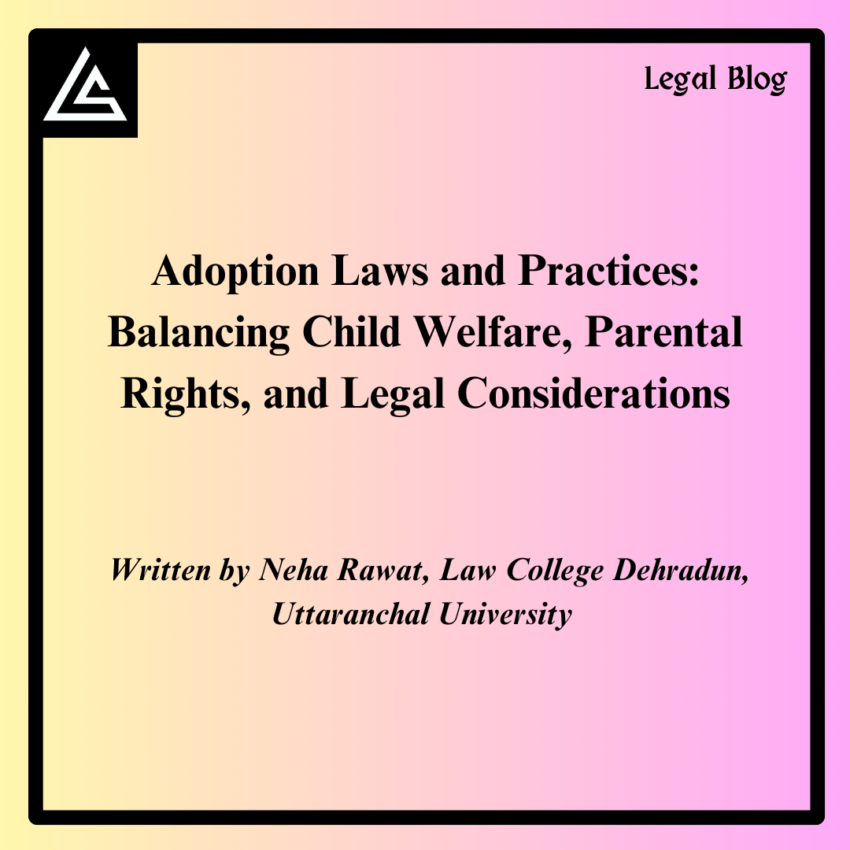Table of Contents
INTRODUCTION
Adoption, as opposed to birth, entails a social and legal procedure to establish a parent-child relationship. Through this procedure, a kid of one set of parents becomes a child of another set of parents. Restoring adoption is necessary to ensure that the kid who has been abandoned, orphaned, and given up has the right to live with a foster family. The adoption process has grown in importance over time for both secular and religious reasons as civilization has developed. Adoption’s primary objectives in the past have been to satisfy a person’s burial rights and preserve their history.
Nonetheless, in recent times, adoption has emerged as a respectable substitute for giving a child who has lost their biological family a family life.
MEANING AND DEFINITIONS
Section 2(2)[1] defines adoption as, “adoption means the process through which the adopted child is permanently separated from his biological parents and becomes the lawful child of his adoptive parents with all the rights, privileges and responsibilities that are attached to a biological child.”
According to Black’s law Dictionary: Adoption is a legal process pursuant to state statute in which a child’s legal rights & duties towards his natural parents are terminated & similar rights & duties towards his adoptive parents are substituted. To take into one’s family the child of another & give him or her rights, privileges & duties of a child & heir. The procedure is entirely statutory & has no historical basis in common law. Most adoptions are through agency placement.” [2]
Adoption not clearly mentioned in the Hindu adoption and maintenance act, 1956. But the Punjab and Haryana High Court in the case of Inder Singh v. Kartar Singh[3],’ the court express adoption as “An adopted child is deemed to have been created by the parent who adopts him or for whom he is adopted. Adoption in Hindu law often refers to the legal recognition of a stranger’s birthright to child rights via attachment and contemplation of Hindu law.”
BALANCING CHILD WELFARE
Gaurav Jain v. Union of India[4] it was enunciated that “Children are ubiquitous, and they are defenceless, innocent, and reliant. Their childhood should evolve alongside them as they age and encounter new situations. It would be a crime against humanity to deny youngsters a firm foundation in life. The kids are looking forward to tomorrow since they are always growing and becoming more aware of their surroundings. There is no other choice; they must be treated, protected, and rehabilitated immediately”.
Adoption can fulfil a very important social purpose in our country, where there are a lot of homeless, abandoned, disabled, and down-out kids. These kids need homes and guardians. On the other hand, a large portion of people, both in India and abroad, are childless. The protest of appropriation is used to provide homes for homeless children and affluent families with children for those who are childless or who have one child and must adopt another.
This is bearing a child for the childless as well as a home, parents, and kids for orphans, impoverished and illegitimate kids who might live in unfavourable circumstances and be abandoned. Adoption thus fulfils two purposes. More care for these underprivileged and abandoned children could more successfully accomplish the religious purpose of adoption. Due to the fact that all laws prioritise the protection of children, the contemporary concept of adoption appears to be more pertinent today.
WHO CAN BE ADOPTED?
A child can be adopted if s/he is:
- An orphan abandoned or surrendered (OAS) child who has been declared legally free for adoption by the Child Welfare Committee (CWC).[5]
- A child of a relative.[6]
- A child or children of spouse from earlier marriage surrendered by the biological parent(s) for adoption by the stepparent.[7]
- A child up to the age of 18 years can be adopted.
- Special need child[8].
LEGAL ASPECT : LAWS (RIGHTS AND LEGAL CONSIDERATION)
The Juvenile Justice (Care & Protection of Children) Act 2000, 2006 (JJA).
The JJA of 2000 covers all Indian citizens. It enables the adoption of two children of the same gender. It confers the status of parents and child, not guardian and ward. It also offers adopted children the same rights as natural children. The JJA of 2000 is intended to provide for the care, protection, development, and rehabilitation of juveniles in conflict with the law and children in need of care and protection, as well as the adjudication and resolution of specific cases involving them. It is akin to the Special Marriage Act of 1954, which allows anyone living in India, regardless of religion, to marry under this act.[9] Thus establish a uniform legal framework of justice all over the country by covering the children up to 18 years of age.
Moreover to make adoptions more kid-friendly, the JJA of 2006 was introduced. ‘Abandoned’ and ‘working child’ or ‘surrendered children’ was added, expanding the concept of “child in need of care and protection.”This act provide no bar to religion for adoption. Extended to all citizen of the country.Further, Eligibility criteria for adoption by Prospective adoptive parents.[10]
Hindu Adoption and Maintenance Act, 1956 (HAMA)
The HAMA extends to only the Hindus, which includes Buddhists, Jains and Sikhs and to any other person who is not a Muslim, Christian, Parsi or Jew by religion[11].
Additionally it covers any child legitimate or illegible, raised by Hindu, Jain, Sikh, Buddhist and who has been abandoned by his/her farther and mother or whose parents are unknown. Prior this act only includes male adoption but now female are also included.
CENTRAL ADOPTION RESOURCE AUTHORITY (CARA)
It was set up on June 20th 1990 to deal with all matters related to adoption across the country. Under the direction of the Ministry of Social Justice and Empowerment of the Indian government, CARA function as a autonomous body. It deal with two type of adoption mainly in country and inter country. The inter country adoption as it was according to the provisions of The Hague convention[12] on inter country adoption, 1993 ratified in 2003 by the government of India. It works with its associated and recognised adoption agencies.
GUARDIANS AND WARDS ACT, 1890
No general laws of adoption present and the religious law of Christians, Parsi, Muslim and Jews does not recognise complete adoption concept. Under this act anyone can became the guardian of the child until he turns 21 year of age. No adoptive rights are provided by this act to the guardian only guardian- ward relationship. The act does not provide the status of a biological child on the adopted child which is given in Hindu Adoption and MaintenanceAct, 1956.
CONCLUSION
Hindu adoption rules have greatly improved, as has the status of women in society. It is ludicrous that Muslims in India are unable to lawfully adopt children due to the absence of a unified civil code governing adoption. Passing the Uniform Civil Code would allow other religions in India to legally adopt children, improving the social life of childless parents.
[1] the Juvenile Justice (Care and Protection of Children) Act, 2015
[2] Bryan, A. Garner, “Black’s Law Dictionary”, (Thomson Business, USA: West Publishing Company, 1990), P 28 to 30)
[3] AIR 1966 P&H 258; ILR(1966) 1 P&H 680;
[4] 1997 8 SCC 114, AIR 1997 SC 3021
[5] (Section 38 and 56 of the JJ Act, 2015 and Regulation 4 of Adoption Regulations)
[6] Ibid
[7] Ibid
[8] special need children means a children who is mentally ill or physically challenged Or both as specified in XVIII of the adoption regulation 2017.
[9] Shabnam Hashmi vs Union Of India & Ors (2014) 4 SCC 144
[10] Regulation 5 of the Adoption Regulation 2017.
[11] Section 2 of the Hindu Adoption and Maintenance Act, 1956.
[12] The Hague Convention on Protection of Children and Co-operation in respect of inter country adoption 1993
Author :- Neha Rawat
Law College Dehradun, Uttaranchal University
share this post on

